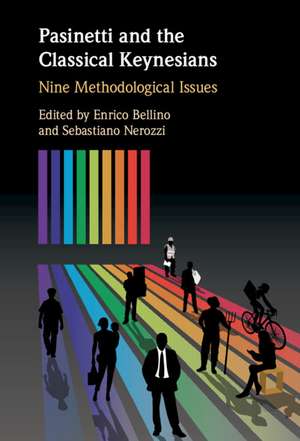Pasinetti and the Classical Keynesians: Nine Methodological Issues
Editat de Enrico Bellino, Sebastiano Nerozzien Limba Engleză Hardback – 23 feb 2022
Preț: 734.04 lei
Preț vechi: 853.55 lei
-14% Nou
Puncte Express: 1101
Preț estimativ în valută:
140.46€ • 153.05$ • 118.36£
140.46€ • 153.05$ • 118.36£
Carte tipărită la comandă
Livrare economică 23 aprilie-07 mai
Preluare comenzi: 021 569.72.76
Specificații
ISBN-13: 9781108831116
ISBN-10: 1108831117
Pagini: 250
Ilustrații: 2 b/w illus.
Dimensiuni: 158 x 235 x 25 mm
Greutate: 0.63 kg
Ediția:Nouă
Editura: Cambridge University Press
Colecția Cambridge University Press
Locul publicării:Cambridge, United Kingdom
ISBN-10: 1108831117
Pagini: 250
Ilustrații: 2 b/w illus.
Dimensiuni: 158 x 235 x 25 mm
Greutate: 0.63 kg
Ediția:Nouă
Editura: Cambridge University Press
Colecția Cambridge University Press
Locul publicării:Cambridge, United Kingdom
Cuprins
Foreword Mauro Baranzini, Alberto Quadrio Curzio and Roberto Scazzieri; Introduction Enrico Bellino, Sebastiano Nerozzi; 1. Reality (and not simply Abstract Rationality) as the Starting Point of Economic Theory Maria Cristina Marcuzzo; 2. Economic Logic with Internal Consistency (and not only Formal Rigor): Beyond Formal Rigour: Realism and Internal Consistency in Piero Sraffa Neri Salvadori, Rodolfo Signorino; 3. Malthus and the Classics (not Walras and the Marginalists) as the Major Inspiring Source in the History of Economic Thought: The Principle of Effective Demand and Classical Economics Heinz D. Kurz; 4. Non-ergodic (in Place of Stationary, Timeless) Economic Systems: Considerations Suggested by Joan Robinson's Distinction between Two 'Notions' of Time in Economic Theory Ariel Dvoskin, Paolo Trabucchi; 5. Causality vs. Interdependence: A Distinction that Conveys a World's View Enrico Bellino, Sebastiano Nerozzi; 6. Macroeconomics before Microeconomics: A Sceptic's Guide to Macroeconomics Murray Milgate, John Eatwell; 7. Disequilibrium: Disequilibrium and Instability (Not Equilibrium) as the Normal State of the Industrial Economies: A Methodological Standpoint on Structural Economic Dynamics Ariel Luis Wirkierman; 8. Necessity of Finding an Appropriate Analytical Framework for Dealing with Technical Change and Economic Growth: Technical Change, Structural Dynamics and Employment Harald Hagemann; 9. A Strong, Deeply Felt, Social Concern Claudia Rotondi; Afterword: Why the Classic-Keynesian Trend May Be of Interest to a Young Scholar Today? Nadia Garbellini; Concluding Remarks: Pasinetti's Separation Theorem Bertram Schefold; Author Index; Subject Index.
Recenzii
'In a very long and extremely productive career, Luigi Pasinetti has made some major contributions to heterodox economic theory from a classical-Keynesian perspective. His methodological claims, however, have received less critical attention. In this original and stimulating volume fifteen scholars explore the important methodological issues raised by Pasinetti, including questions of realism, rigour, ergodicity, causation, disequilibrium and the supposed microfoundations of macroeconomics. Essential reading!' John E. King, La Trobe University
Descriere
Nine leading scholars discuss the nine main ideas that, according to Luigi Pasinetti, characterize the Classical-Keynesian approach.
